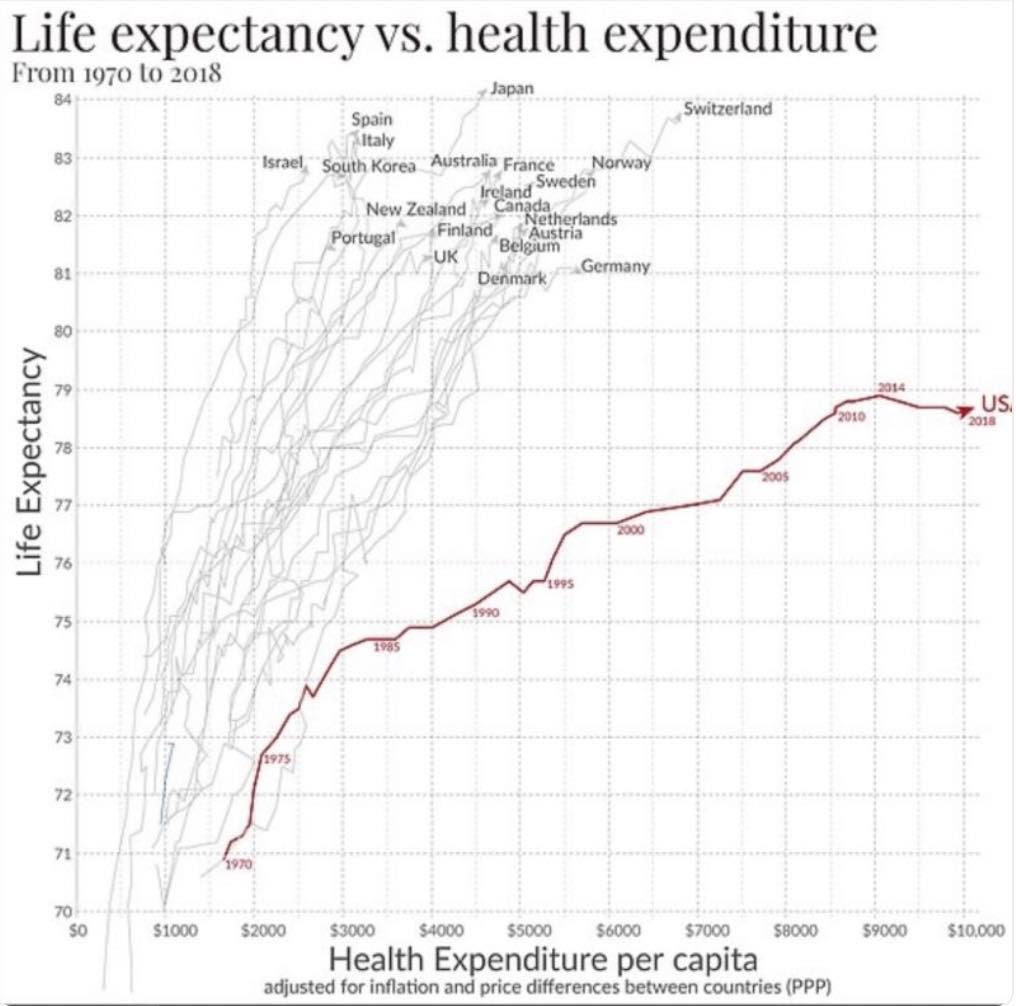Out of Control Health Costs or a Broken Society
0 View
Share this Video
- Publish Date:
- 10 October, 2023
- Category:
- Holistic
- Video License
- Standard License
- Imported From:
- Youtube
Tags

Flawed Accounting for the US Health Spending Problem
By Jeff Goldsmith

Source: OECD, Our World in Data
Late last year, I saw this chart which made my heart sink. It compared US life expectancy to its health spending since 1970 vs. other countries. As you can see, the US began peeling off from the rest of the civilized world in the mid-1980’s. Then US life expectancy began falling around 2015, even as health spending continued to rise. We lost two more full years of life expectancy to COVID. By the end of 2022, the US had given up 26 years-worth of progress in life expectancy gains. Adding four more years to the chart below will make us look even worse.
Of course, this chart had a political/policy agenda: look what a terrible social investment US health spending has been! Look how much more we are spending than other countries vs. how long we live and you can almost taste the ashes of diminishing returns. This chart posits a model where you input health spending into the large black box that is the US economy and you get health out the other side.
The problem is that is not how things work. Consider another possible interpretation of this chart: look how much it costs to clean up the wreckage from a society that is killing off its citizens earlier and more aggressively than any other developed society. It is true that we lead the world in health spending. However, we also lead the world in a lot of other things health-related.
Exceptional Levels of Gun Violence
Americans are ten times more likely than citizens of most other comparable countries to die of gun violence. This is hardly surprising, since the US has the highest rate of gun ownership per capita in the world, far exceeding the ownership rates in failed states such as Yemen, Iraq and Afghanistan. The US has over 400 million guns in circulation, including 20 million military style semi-automatic weapons. Firearms are the leading cause of deaths of American young people under the age of 24. According to the Economist, in 2021, 38,307 Americans aged between 15 and 24 died vs. just 2185 in Britain and Wales. Of course, lots of young lives lost tilt societal life expectancies sharply downward.
A Worsening Mental Health Crisis
Of the 48 thousand deaths from firearms every year in the US, over 60% are suicides (overwhelmingly by handguns), a second area of dubious US leadership. The US has the highest suicide rate among major western nations. There is no question that the easy access to handguns has facilitated this high suicide rate.
About a quarter of US citizens self-report signs of mental distress, a rate second only to Sweden. We shut down most of our public mental hospitals a generation ago in a spasm of “de-institutionalization” driven by the arrival of new psychoactive drugs which have grossly disappointed patients and their families. As a result, the US has defaulted to its prison system and its acute care hospitals as “treatment sites”; costs to US society of managing mental health problems are, not surprisingly, much higher than other countries. Mental health status dramatically worsened during the COVID pandemic and has only partially recovered.
Drug Overdoses: The Parallel Pandemic
On top of these problems, the US has also experienced an explosive increase in drug overdoses, 110 thousand dead in 2022, attributable to a flood of deadly synthetic opiates like fentanyl. This casualty count is double that of the next highest group of countries, the Nordic countries, and is again the highest among the wealthy nations. If you add the number of suicides, drug overdoses and homicides together, we lost 178 thousand fellow Americans in 2021, in addition to the 500 thousand person COVID death toll. The hospital emergency department is the departure portal for most of these deaths.
Maternal Mortality Risks
The US also has the highest maternal mortality rate of any comparable nation, almost 33 maternal deaths per hundred thousand live births in 2021. This death rate is more than triple that of Britain, eight times that of Germany and almost ten times that of Japan. Black American women have a maternal mortality rate almost triple that of white American women, and 15X the rate of German women. Sketchy health insurance coverage certainly plays a role here, as does inconsistent prenatal care, systemic racial inequities, and a baseline level of poor health for many soon-to-be moms.
Obesity Accelerates
Then you have the obesity epidemic. Obesity rates began rising in the US in the late 1980’s right around when the US peeled away from the rest of the countries on the chart above. Some 42% of US adults are obese, a number that seemed to be levelling off in the late 2010’s, but then took another upward lurch in the past couple of years. Only the Pacific Island nations have higher obesity rates than the US does. And with obesity, conditions like diabetes flourish. Nearly 11% of US citizens suffer from diabetes, a sizable fraction of whom are undiagnosed (and therefore untreated). US diabetes prevalence is nearly double that of France, with its famously rich diets.
Causes of obesity include: poverty and racial inequity, poor diet, lack of physical activity, prepared foods laden with processed sugar and salt, food desserts, etc. There has been an eerie correlation between the decline in adult smoking and the rise in obesity; one lethal anxiety reducer replacing another beginning in the late 1980’s, right around the time our health costs peeled away from the rest of the world vs. life expectancy. Our high rate of obesity undoubtedly contributed to the US death toll from COVID. More than 70% of COVID casualties among the US population were obese or overweight. Obesity rendered the infected vulnerable to breathing and circulatory problems aggravated by COVID.
Our Appalling COVID Performance
And of course, per capita deaths from COVID in the US, though not the highest in the world, significantly exceeded the death tolls in most wealthy nations. According to the Economist, we lost between 1.3 and 1.4 million people to COVID., the third most “excess deaths” of any country (after India and Russia).* Our peer group in the rate of excess deaths per thousand during the pandemic included: Kazakhstan, Greece, Brazil and Estonia.
Countries that excelled in combatting this pandemic, which had death rates less than one-fifth of ours- New Zealand, Taiwan, Japan, South Korea- seem to share two traits in common: competent governments capable of acting quickly and decisively to manage public health risks and populations that respected both scientific authority and public health mandates. In the US, we lacked both of these things.
* Excess deaths- deviation above the normal predicted level of deaths in a year- may be a better measure of the pandemic’s effects than “official” COVID deaths, due to complexities in attribution of deaths to specific causes and political interference by governmentToxic Libertarianism
During the pandemic, an ethos of F#@ck You Libertarianism took firm hold in much of the US: “My right to go bowling is more important than your right to be disease free! You are NOT the boss of me!” A gross imbalance between individual rights and responsibilities to the society manifest itself in resistance to masking, social distancing and vaccination. The same objections “libertarians” had to COVID precautions apply equally to traffic signals or drunk driving restrictions, which are also abridgements of individual rights in service of a common good. Basic and sensible public health measures became politicized in a tidal wave of social media-fired nonsense; any doofus with an Internet connection became his or her own epidemiologist or virologist. Public health is now, to many Americans, an elitist conspiracy to deprive them of their freedom.
And the resistance was well armed. A not-so-well-regulated militia of local citizens armed with semi-automatic weapons and walkie-talkies turned up to reopen the Crash and Burn Tattoo Parlor in Shepherd, Texas in April, 2020. Radical libertarian militiamen were convicted of a plot to kidnap and murder the Governor of Michigan based on her enforcement of pandemic closures! Not a Failed Economy but a Struggling Society
The US has certainly not failed as an economy. A recent Economist analysis show us pulling away from our European peers in wealth generation. It had a similar record in productivity growth. So it isn’t a resource shortage that is holding us back. The US is also not a failed state; it fought off a coup attempt after the 2020 federal election, and successfully defended the integrity of its election system in the 2022 mid -terms.
But US society’s performance has been truly cringe-worthy. Start with a base layer of income inequality and the resultant unresolved racial and social class antagonisms, stir in pervasive obesity, widespread depression, anxiety, and a high ambient level of anger, add over 400 million lethal weapons, flood with fentanyl and then a lethal virus and you are left with the chart which we began this essay. In the inimitable words of Walt Kelly’s Pogo: “We have met the enemy and he is us”.
Health System Not Blameless
We cannot and should not absolve our health care system of blame; it is 17.3% of our economy. Our pharmaceutical industry, including wholesalers and retailers, lit the match that exploded into the epidemic of opioid addiction and deaths. But other corporate interests have contributed materially to the broader decline in Americans’ health. Our food industry -fast and otherwise-bears a lot of responsibility for the flood of cheap calories and oversalted prepared foods. Gun manufacturers and Second Amendment absolutists have facilitated not only the explosion of gun ownership, but the inability sensibly to restrict their use.
And we can thank two generations of distracted state and national political leadership of both parties, and an ethos of “don’t worry, the market will fix it”, for abandoning our inner cities and much of rural America notably the Deep South and “greater Appalachia”. This malign neglect created economic conditions that narrowed life choices, and a marked disparity in life expectancy depending on where you live (see map below). It also helped foster a deep and festering resentment among those who were left behind which found its expression in the election of Donald Trump and in the rioting that followed the George Floyd murder.
What Isn’t Going to Matter Much
Is our health system too costly both to individuals and to US society? Absolutely. But the forces that push up the demand for care and generate those health costs are deeply imbedded in a poorly functioning society. The current roster of health policy nostrums favored by academia, the policy commentariat and the consulting community – “price transparency”, further shifting of health costs onto strained household budgets, converting Medicare to a voucher program instead of a “service benefit,” state administered hospital price controls and yet another wave of futile technocratic payment system tinkering for hospital and physician care such as that launched by ObamaCare – do not even graze the underlying problem.
What Might Actually Help
There are things we can do that might make a difference. We can create a safe “third place” besides prison and the acute care hospital for schizophrenics and others of danger to themselves or others (and dramatically reduce incarceration rates while at it). We can do a much better job of keeping the mentally disturbed away from firearms. We can break the cycle of revenge-driven shootings by intervening sensibly at the neighborhood level. We can also do a much better job of managing addiction in a humane and thoughtful fashion, by dramatically expanding both the quality and availability of addiction treatment.
We can raise taxes on salt and processed sugar added to food, and use the money to fund research into food addiction. We can also reduce taxes on fresh fruit and vegetables to make them more affordable to the poor and near poor. Most importantly, we can dramatically improve our system of social care, particularly support for family care-giving, as Elizabeth Bradley and Lauren Taylor suggested in their outstanding The American Healthcare Paradox. Anything we can do to strengthen American families’ ability to remain together will make a material difference in Americans’ health and reduce pressure on health spending. And even with all the pandemic related extensions of health coverage, 28.5 million Americans still lacked health coverage in 2022, whose costs of care were shifted onto the rest of us.
Fixing Broken Regional Economies
But none of this will matter much unless we can reverse the outflow of public and investor capital from the abandoned localities in our country, both urban and rural, and create dignified and lasting employment for those that live there. Life expectancy differences closely mirror the health of local economies. If the hospital is the largest employer in many of these communities, as it is, that is not an economically sustainable state of affairs.
It is not random that the lowest life expectancies in the US (fifteen years or twenty years lower than the national averages in some counties) can be founded in regions of the US such as Appalachia and the Deep South that have struggled economically for more than fifty years. Buz Cooper convincingly argued in his brilliant Poverty and the Myths of Health Reform, that poverty and all its sickness-inducing correlates is the most important driving force in health spending, not flawed payment schemes or oversupply of care system resources.

Source: US Census Bureau
The country is so big, both in geography and population, that it is difficult to understand or appreciate how things are for others that are geographically remote from us. But travel writer Paul Theroux, in his Deep South, said he found poverty in the American South that was worse than what he has seen in rural Africa. There are significant health (and political) consequences for this poverty.
Given the fragmentation, how we can get Americans to actually focus on helping each other may be the most difficult problem of all. It is galling to see totalitarian societies like China use our current troubles to justify stripping their own citizens of their freedom and dignity and abusing their human rights in the name of “social order”.
By the time those who have been damaged by neglect reach the Emergency Department, it is too late to help most of them. Our present flawed social accounting system blames the health care system for the cost of patching up the damage from all the problems enumerated above. . You do not need a doctorate in sociology to realize that the problems that generate all those health costs lie much deeper. They are soluble problems. We must use our wealth, ingenuity and boundless American energy to foster a sense of mutual responsibility that transcends racial, ethnic and social class boundaries to fix these problems.
An excellent NPR report in March, 2023 entitled “Live Free and Die” explored these issues, as did a similarly excellent April, 2023 piece in the Economist.
Jeff Goldsmith is the President of Health Futures Inc














